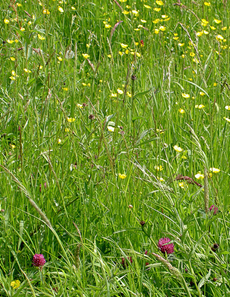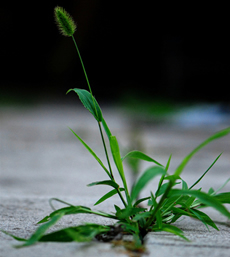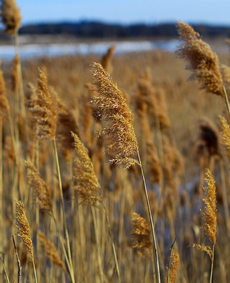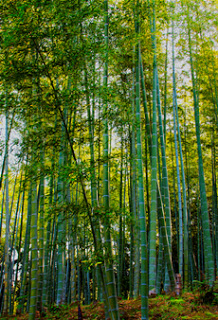Agriculture
Grasses are monocotyledonous flowering plants (phylum Anthophyta, the angiosperms) belonging to the family Poaceae, formerly Gramineae. The family is widespread and economically very valuable. All the grasses are herbaceous except for the bamboos, some of which are treelike.
Grasses arose seventy million to eighty million years ago, in the Late Cretaceous period of the Mesozoic era. They succeeded partly because they concentrate their growth lower down on the leaf and stem than other plants do and thus can regenerate quickly when fire or herbivores remove the top part of the plant.
This makes them ideal for human uses such as lawns and pasture for domestic livestock. Grasses are a very important food source for humans. Grasses provide all cereal grains?barley, corn, millet, oats, rice, rye, and wheat. Other grasses used for food include sorghum, sugarcane, and bamboo.
The grass family is important botanically and ecologically, too. With about 650 genera and 7,500 to 10,000 species, it is the fourth largest angiosperm family. In number of individual plants, it far outranks any other flowering plant family, composing the natural vegetation of about one-quarter of the earth?s land surface.
The family is especially abundant in semiarid climates and has the widest range of all the angiosperm families.Grasses provide a vital food source for many grazing, wild animals. By binding the soil with their roots, grasses protect it from erosion. In addition, grasses build up the soil when they die and decompose.
Stems, Roots, and Leaves
The above ground stems of grasses are called culms. The roundness of culms distinguishes grasses from similar-looking plants, the sedges and rushes, which have differently shaped stems.
Grass culms are divided into nodes, or joints, which are solid, and internodes (the regions between the nodes), which are usually hollow. Elongation of the culm occurs mainly at the bases of the internodes, rather than at the stem tip as in most plants.
Grasses range in height from only a few centimeters, in annual bluegrass, to 30 or 40 meters, in treelike bamboos. Grasses may have underground stems, or rhizomes. The roots are slender and fibrous and for man extensive system that may compose a large proportion of the plant?s total biomass. This large root system helps grasses obtain water in dry regions.
The leaves of grasses are generally arranged alternately on the stem and have no petiole, or stalk. The lower part of the leaf, the sheath, is wrapped around the culmlike a split tube and is attached at its base to a node. The upper part of the leaf, the blade, diverges from the culm and is slender and elongated, tapering to a point at the tip.
Flowers and Fruits
Pollinated by the wind, grass flowers are simple and inconspicuous individually. They have stamens and pistils?the essential male and female reproductive structures?but lack petals and sepals, which most other angiosperms use to lure insect pollinators.
Many grass flowers have three stamens and a single pistil that has two stigmas. Long, dangling anthers in the stamens and long, feathery stigmas help the wind transfer pollen efficiently from stamen to pistil.
Identification of grass species is based to a considerable extent on flower arrangement and characteristics of modified leaves, called bracts, that surround the flowers.
Individual flowers, called florets, are usually arranged in clusters, called spikelets. Each floret and spikelet typically has at its base a pair of bracts. The spikelets may be crowded on an unbranched stalk, forming a spike, or borne at the ends of stalks having many branches, in a panicle.
The grass fruit, called a caryopsis, or grain, consists of a single seed with its seed coat firmly adherent to the thin fruit wall. Wind plays a major role in dissemination of the fruits. Grasses may germinate, grow, set seed, and die in the same year (annuals)or live and produce seed for many years (perennials).
Bamboos
The bamboos are perennial, often treelike, grasses belonging to the Bambusoideae, a subfamily that is thought to be an early offshoot in the grass family lineage. Bamboo taxonomy is poorly understood. One estimate holds that there are roughly 45 genera and 480 species.
Like other grasses, bamboos have jointed culms, which are hollow except at the nodes, where there are partitions. The culms, which originate from rhizomes, are often called canes. The canes are light and elastic. Their hardness is due not to secondary xylem, or wood, as in most trees and shrubs, but rather to scattered fibers in the outer walls of the cane internodes.
Canes of some bamboo species grow at rates as high as a meter a day. The upper nodes of fully elongated culms give rise to small, horizontal branches. Leaves are borne on these branches or on branches of these branches. The blades are narrow and often short. Although some bamboos flower every year, many bloom only at the end of their lifetimes, which may range from 10 to 120 years.
Bamboos are distributed mainly in tropical and subtropical regions, with large concentrations in Asia and South America. A few species reach mild temperate areas. In the United States, there is a single native species, Arundinaria gigantea, called cane. It forms canebrakes in southern bottom lands. Bamboos are grown as ornamentals in many parts of the world.
Dense bamboo thickets are sometimes planted as living fences or barricades. In Asia, bamboos are very significant economically, providing materials for building, matting, and many other purposes. The young shoots are popular as food in eastern Asia.
- African Flora
African Flora With few exceptions, Africa?s flora (vegetation) is tropical or subtropical. This is primarily because none of the African continent extends far from the equator, and there are only a few high-elevation regions that support more temperate...
- Grasslands
Mongolian grassland Grasslands are areas of intermittent rainfall which favor grass growth. The grass helps the soil become rich by facilitating the accumulation of nutrients and decaying plant material. Grasslands once covered about a quarter of the...
- Monocots Vs Dicots
Within the angiosperms (flowering plants), two classes have been traditionally recognized by botanists: monocots and dicots. The terms connote differences between these groups? seed embryos. The recently introduced class, eudicots, literally meaning ?true...
- Monocotyledones
MonocotyledonesThe Monocotyledones, or monocots, are a large and very distinctive class of angiosperms or flowering plants, phylum Anthophyta, consisting of some 133 families, 3,000 genera, and 65,000 species. Monocotyledones form one of the two major...
- Range Grasses--screening And Nutrient Management
A study on ?secreening and nutrient management of different indigenous range grasses in Thal range area of Punjab? was carried out during 2007-08 at University of Agriculture,Faisalabad and Muzzafargar (Thal area) respectively. Germination vigor of buffle...
Agriculture
Grasses and Bamboos
 |
| Grasses |
Grasses arose seventy million to eighty million years ago, in the Late Cretaceous period of the Mesozoic era. They succeeded partly because they concentrate their growth lower down on the leaf and stem than other plants do and thus can regenerate quickly when fire or herbivores remove the top part of the plant.
This makes them ideal for human uses such as lawns and pasture for domestic livestock. Grasses are a very important food source for humans. Grasses provide all cereal grains?barley, corn, millet, oats, rice, rye, and wheat. Other grasses used for food include sorghum, sugarcane, and bamboo.
The grass family is important botanically and ecologically, too. With about 650 genera and 7,500 to 10,000 species, it is the fourth largest angiosperm family. In number of individual plants, it far outranks any other flowering plant family, composing the natural vegetation of about one-quarter of the earth?s land surface.
  |   |
The family is especially abundant in semiarid climates and has the widest range of all the angiosperm families.Grasses provide a vital food source for many grazing, wild animals. By binding the soil with their roots, grasses protect it from erosion. In addition, grasses build up the soil when they die and decompose.
Stems, Roots, and Leaves
 |
| Stems, Roots, and Leaves |
Grass culms are divided into nodes, or joints, which are solid, and internodes (the regions between the nodes), which are usually hollow. Elongation of the culm occurs mainly at the bases of the internodes, rather than at the stem tip as in most plants.
Grasses range in height from only a few centimeters, in annual bluegrass, to 30 or 40 meters, in treelike bamboos. Grasses may have underground stems, or rhizomes. The roots are slender and fibrous and for man extensive system that may compose a large proportion of the plant?s total biomass. This large root system helps grasses obtain water in dry regions.
The leaves of grasses are generally arranged alternately on the stem and have no petiole, or stalk. The lower part of the leaf, the sheath, is wrapped around the culmlike a split tube and is attached at its base to a node. The upper part of the leaf, the blade, diverges from the culm and is slender and elongated, tapering to a point at the tip.
Flowers and Fruits
 |
| Flowers |
Many grass flowers have three stamens and a single pistil that has two stigmas. Long, dangling anthers in the stamens and long, feathery stigmas help the wind transfer pollen efficiently from stamen to pistil.
Identification of grass species is based to a considerable extent on flower arrangement and characteristics of modified leaves, called bracts, that surround the flowers.
 |
| Flowers and Fruits |
The grass fruit, called a caryopsis, or grain, consists of a single seed with its seed coat firmly adherent to the thin fruit wall. Wind plays a major role in dissemination of the fruits. Grasses may germinate, grow, set seed, and die in the same year (annuals)or live and produce seed for many years (perennials).
Bamboos
The bamboos are perennial, often treelike, grasses belonging to the Bambusoideae, a subfamily that is thought to be an early offshoot in the grass family lineage. Bamboo taxonomy is poorly understood. One estimate holds that there are roughly 45 genera and 480 species.
Like other grasses, bamboos have jointed culms, which are hollow except at the nodes, where there are partitions. The culms, which originate from rhizomes, are often called canes. The canes are light and elastic. Their hardness is due not to secondary xylem, or wood, as in most trees and shrubs, but rather to scattered fibers in the outer walls of the cane internodes.
 |
| bamboos |
Bamboos are distributed mainly in tropical and subtropical regions, with large concentrations in Asia and South America. A few species reach mild temperate areas. In the United States, there is a single native species, Arundinaria gigantea, called cane. It forms canebrakes in southern bottom lands. Bamboos are grown as ornamentals in many parts of the world.
Dense bamboo thickets are sometimes planted as living fences or barricades. In Asia, bamboos are very significant economically, providing materials for building, matting, and many other purposes. The young shoots are popular as food in eastern Asia.
- African Flora
African Flora With few exceptions, Africa?s flora (vegetation) is tropical or subtropical. This is primarily because none of the African continent extends far from the equator, and there are only a few high-elevation regions that support more temperate...
- Grasslands
Mongolian grassland Grasslands are areas of intermittent rainfall which favor grass growth. The grass helps the soil become rich by facilitating the accumulation of nutrients and decaying plant material. Grasslands once covered about a quarter of the...
- Monocots Vs Dicots
Within the angiosperms (flowering plants), two classes have been traditionally recognized by botanists: monocots and dicots. The terms connote differences between these groups? seed embryos. The recently introduced class, eudicots, literally meaning ?true...
- Monocotyledones
MonocotyledonesThe Monocotyledones, or monocots, are a large and very distinctive class of angiosperms or flowering plants, phylum Anthophyta, consisting of some 133 families, 3,000 genera, and 65,000 species. Monocotyledones form one of the two major...
- Range Grasses--screening And Nutrient Management
A study on ?secreening and nutrient management of different indigenous range grasses in Thal range area of Punjab? was carried out during 2007-08 at University of Agriculture,Faisalabad and Muzzafargar (Thal area) respectively. Germination vigor of buffle...
